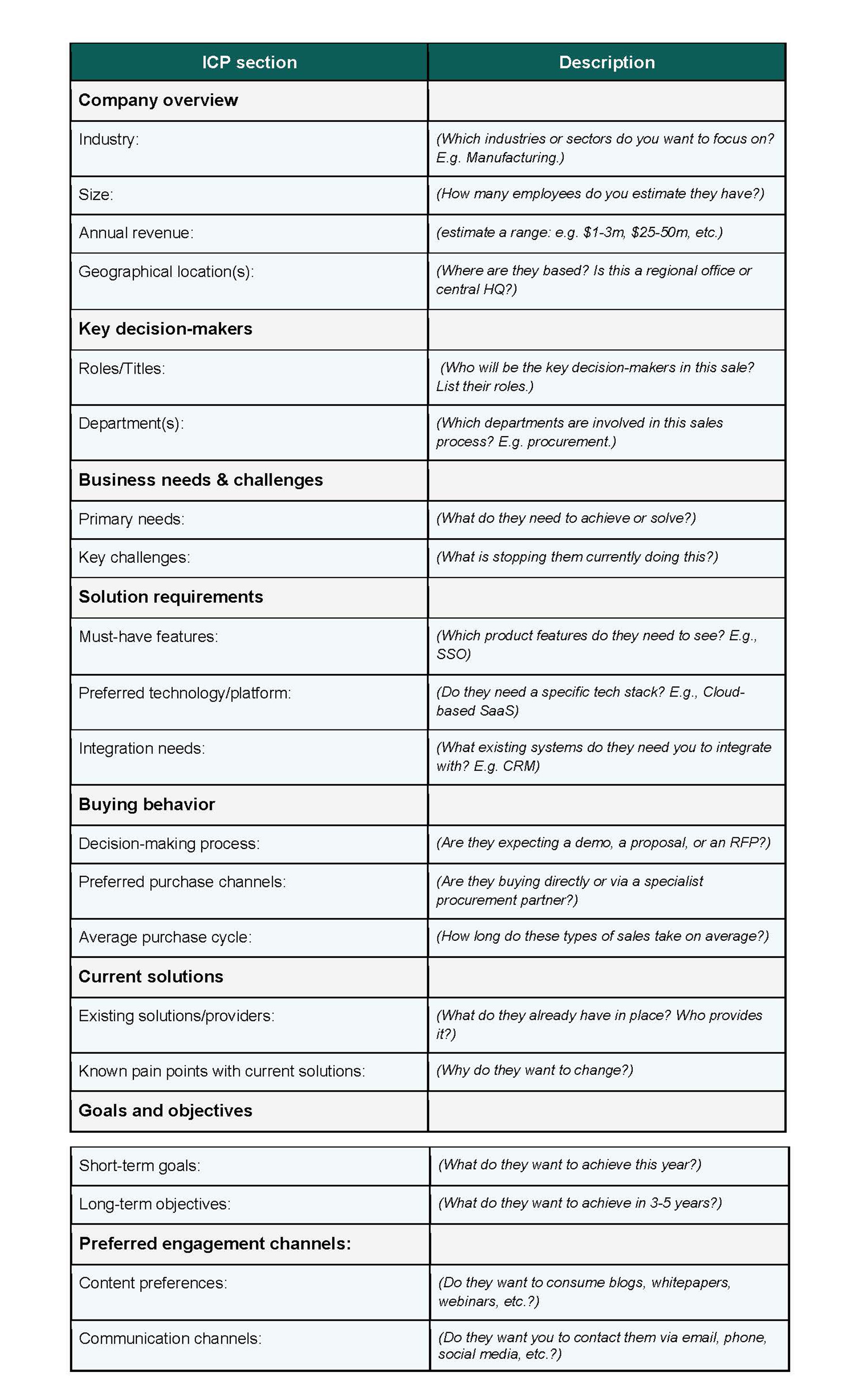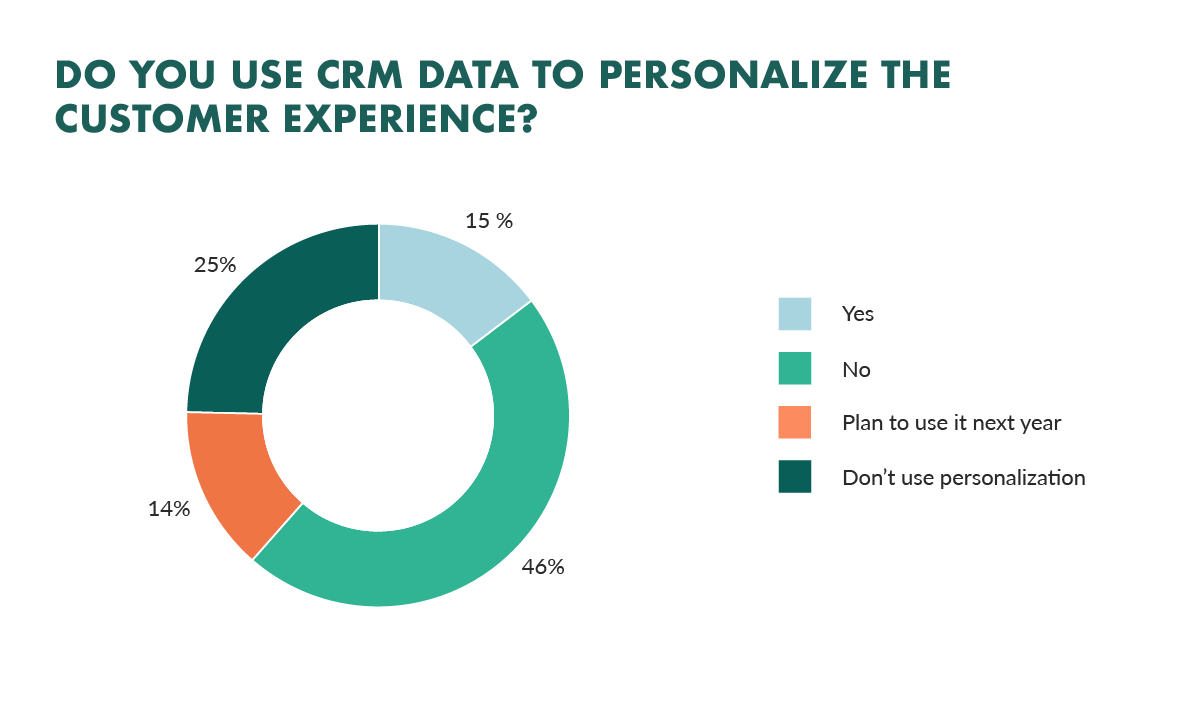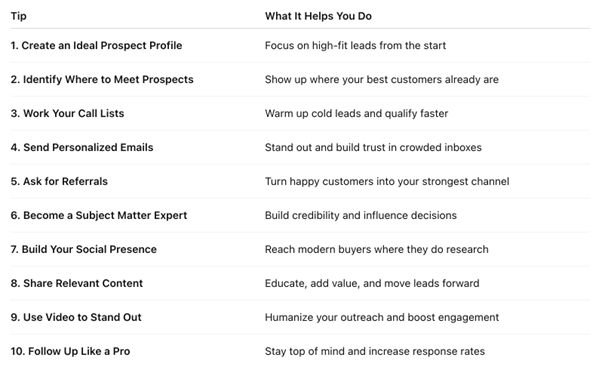Prospecting is where every deal starts - and where most salespeople struggle.
In fact, 42% of reps say it’s the most difficult part of the sales process.
It’s no surprise. Prospecting doesn’t feel as rewarding as closing. It takes time, consistency, and often a lot of rejection. But without a steady stream of qualified leads in your pipeline, nothing else moves forward.
That’s why top-performing reps don’t leave prospecting to chance - or to marketing. They block time for it, treat it as a daily discipline, and use tools like CRM to help them stay on track.
And it pays off: Salespeople who consistently prospect generate up to 2.7x more conversions than those who don’t.
In this guide, you’ll learn 10 prospecting techniques that modern sales pros use to connect with more of the right buyers - plus practical tips to help you work smarter, not just harder.
Today’s Buyers Are Different. So Is Prospecting.
Before we dive into the tactics, it’s worth noting: prospecting has changed.
Today’s buyers do their own research. They spend just 17% of their buying time meeting with potential vendors - and less than 6% with any single sales rep.
But here’s the good news: buyers still want to hear from you.
In fact, 91% of them are open to engaging with a sales rep early in the process - especially if you reach out with insight, not just a pitch.
And 74% of buyers say they choose the first sales rep who adds value - which means timing and relevance are everything.
The key is to show up where they are, with something relevant to say.
Let’s explore 10 smart ways to do exactly that.
1. Start with a Real Ideal Prospect Profile
If you try to sell to everyone, you’ll end up closing no one. That’s why every great prospecting strategy starts with focus.
Instead of casting a wide net, define what your ideal customer profile (ICP) looks like for your business. Use data from your CRM to analyze:
- Who your top 5 customers are (and what they have in common)
- Which accounts have the highest lifetime value
- Which industries or company sizes tend to convert fastest
Then, flip the lens: Who drains your time with low return? Who churns quickly or doesn’t find lasting value? These insights help you steer clear of poor-fit prospects and zero in on the ones worth your energy.

Why this matters: 50% of your prospects are not a good fit for what you sell.
Once your ICP is clear, use it as a filter for LinkedIn searches, inbound lead scoring, and outreach planning.
💡 Tools like SuperOffice CRM let you segment your database and build focused lists based on criteria like deal size, industry, and behavior - so you’re not wasting time on the wrong prospects.
2. Find Out Where Your Best Prospects Actually
Are Great prospects don’t just appear - you need to know where to find them.
Start by looking back: Where did your best current customers first come from? Was it a referral, a webinar, LinkedIn outreach, a trade show? This tells you where to reinvest your time and budget.
Then, go deeper:
- What newsletters, industry sites, or forums do your target buyers follow?
- What events (virtual or in-person) do they attend?
- Which influencers or analysts do they trust?
This insight helps you show up in the right places - whether it’s speaking at events, posting on LinkedIn, or targeting ads on specific platforms.
If your top accounts came from LinkedIn, double down. Build your presence, comment on industry posts, and share relevant insights - not just pitches.
💡With a CRM, you can track which channels or campaigns brought in your highest-converting leads - and use that data to double down on what works.
3. Work Your Call Lists Like a Pro
Cold calling isn’t dead - it’s just evolved.
Buyers still answer calls… if there’s a reason to. Research shows 69% of buyers have accepted calls from new salespeople. But they’re quick to tune out if the call feels generic or pushy.
Instead of dialing for dollars, treat your call list like a curated hit list:
- Prioritize warm leads (e.g., recent downloads, webinar attendees, or engaged contacts from your CRM)
- Prepare 2–3 questions tailored to their industry or company role
- Aim to understand, not to pitch - your goal is to open a conversation, not close a deal
According to Gong, sales reps who ask 11–14 thoughtful questions during discovery calls see a 74% higher success rate.
And don’t forget the follow-up. Your first call may not get a meeting - but it gets you noticed. Use a CRM to log every call, schedule next steps, and set reminders. That way, no lead falls through the cracks.
4. Make Your Emails Impossible to Ignore
Inboxes are crowded. But good emails still win.
80% of buyers prefer to be contacted via email - but they’re ruthless with delete buttons.
The difference-maker? Personalization.

Effective prospecting emails:
- Reference something specific (their company, a recent news item, or a shared connection)
- Address a real challenge or opportunity they’re likely facing
- Offer value - an idea, insight, or invitation that earns a response
What doesn’t work? Vague intros, feature dumps, or the dreaded “just checking in.”
💡SuperOffice CRM can help you personalize at scale - with dynamic fields, email templates, and engagement tracking that shows who’s opening, clicking, and worth a follow-up. Find out more.
5. Ask for Referrals (and Make It Easy to Say Yes)
Referrals aren’t just warm - they’re red-hot.
When a happy customer refers you, it builds instant trust. That’s why referral-based deals close at 50–70% and tend to be more profitable over time.
Yet, only 11% of salespeople consistently ask for referrals.
Make referrals part of your sales process, not an afterthought. Here's how:
- Ask immediately after a successful onboarding or milestone moment
- Be specific: “Do you know one other company that’s also struggling with [insert common pain point]?”
- Make it frictionless - offer to draft a message they can forward or share your calendar link directly
73% of decision-makers prefer to work with salespeople referred by someone they trust.
Need help tracking referrals and automating follow-ups? Talk to a CRM expert and learn how SuperOffice can streamline your outreach process.
6. Become a Trusted Expert (Not Just a Seller)
Buyers don’t want a pitch - they want a partner.
In B2B, 79% of prospects want their sales rep to act as a trusted advisor, not a vendor. That means showing up with relevant knowledge, insight, and context - not just a product sheet.
Position yourself as the go-to expert by:
- Sharing thoughtful commentary on industry trends via LinkedIn
- Tailoring your outreach based on their specific business challenges
- Asking smarter questions and offering data-driven suggestions
More than 50% of top-performing sales reps are seen as subject matter experts by their customers.
💡With SuperOffice CRM, you can easily log notes from past conversations, view buying history, and track customer goals - so your advice is always informed and personalized.
7. Build Your Presence Where Your Buyers Are
Buyers research, vet, and form opinions long before you reach out.
And increasingly, they’re doing it on social.
That’s why 91% of B2B buyers are active on social media, and 84% of executives use social to support purchasing decisions.
To meet buyers where they are:
- Optimize your LinkedIn profile for trust and clarity - not just titles and accolades
- Share useful, not salesy, insights regularly (think: industry trends, helpful articles, quick tips)
- Engage authentically - comment on your buyers’ content, share others’ wins, and start conversations
Social selling isn’t about broadcasting. It’s about building credibility before the first call.
Best of all:
Sales reps who use social selling outsell their peers 78% of the time.
💡With SuperOffice CRM, you can capture social interactions as part of your customer record. Talk to a CRM expert today to learn more.
8. Share Content That Speaks to Their Pain Points
Generic content doesn’t convert.
If your emails, PDFs, or follow-ups only talk about your features, you’re not helping the buyer solve anything. At the prospecting stage, what they really want is clarity: “Do you understand my problem - and can you help?”
To stand out:
- Share content tailored to the prospect’s industry, stage, or known challenges
- Use data, trends, or benchmarks they can use in internal conversations
- Prioritize helpfulness over hype
Nearly 9 out of 10 (89%) of B2B buyers say content that shows clear ROI is most persuasive.
And here’s where your CRM becomes a content engine. With SuperOffice, you can tag contacts by segment, track which content converts, and build follow-up flows that feel smart - not spammy.
9. Use Video to Personalize, Humanize, and Stand
Out In a crowded inbox, nothing stops the scroll like a human face.
Video isn’t just a marketing tool anymore - it’s a powerful, personal way for sales reps to cut through the noise, introduce themselves, and add real warmth to outreach.
Use short videos to:
- Introduce yourself after a cold outreach or connection request
- Summarize key points after a sales call
- Walk through a proposal or explain a use case visually
It’s not about polished production. It’s about being real, relevant, and respectful of their time.
According to GetAccept, emails that include video see up to an 8x higher reply rate - especially when sent in the early prospecting stage.
💡With SuperOffice CRM, you can track video engagement, follow up based on actual views, and personalize the next step - right from your sales dashboard.
10. Follow-Up Like a Pro (Because Most Reps Don’t)
Here’s the brutal truth:
Most deals die because no one followed up.
Prospects get busy. Emails get buried. But 80% of sales require 5+ follow-ups, while 44% of reps give up after just one.
Following up shows professionalism, persistence, and genuine interest. But it also needs to be done right:
- Use a mix of channels: email, phone, LinkedIn
- Add value with each message - don’t just “check in”
- Space out your outreach (without ghosting for weeks)
- Keep notes, track conversations, and set reminders
We promise you. It’s worth it.
A single extra follow-up can increase reply rates by 65%.
💡Inside SuperOffice CRM, follow-ups aren’t left to chance. You can set automatic reminders, trigger actions based on contact behaviour, and keep every touchpoint logged - so the right message always reaches the right person, at the right time.
Prospecting is a Skill. Discipline Turns It Into a Superpower.
If you take away one thing, it’s this: consistency beats intensity.
The best sales reps aren’t just lucky. They block time, work the process, and use tools that support their momentum - every day. And when they prospect with purpose, they don’t just fill pipelines… they create better outcomes.
Need a quick refresher on the 10 strategies we covered? Here’s your at-a-glance summary:

Whether you're just getting started or fine-tuning your outbound strategy, these fundamentals will keep your pipeline healthy - and help you connect with the right buyers at the right time.
Turning Tactics Into Consistency
The tips above aren’t quick hacks - they’re habits. Habits that top-performing sales reps use every day to build relationships, open doors, and move opportunities forward.
But habits need support. And that’s where tools, time blocks, and team alignment come in. The more structure you give your prospecting efforts, the more scalable - and successful - they become.
Because at the end of the day, prospecting isn’t just about finding leads. It’s about building a repeatable, reliable way to fuel growth.
Ready to prospect smarter, not harder?
If your current tools don’t support your process - or if you're juggling too many spreadsheets - SuperOffice CRM can help you:
- Prioritize your best-fit prospects
- Automate reminders and follow-ups
- Track calls, emails, and video views
- Align sales activity with actual outcomes
Let’s talk. Book a personalized demo and we’ll show you how SuperOffice CRM makes prospecting easier, faster, and more effective for modern sales teams.



